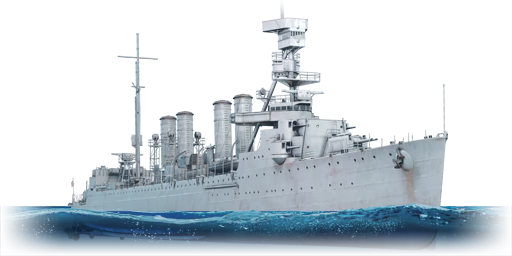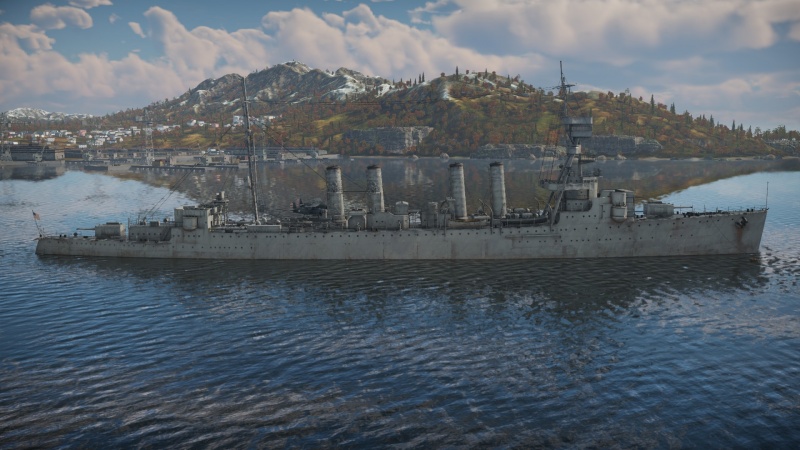Difference between revisions of "USS Trenton"
(Updated format) |
m (U38088265 moved page USS Trenton (CL-11) to USS Trenton: Renamed in 2.7) |
(No difference)
| |
Revision as of 23:25, 2 June 2021
Contents
Description
The Omaha-class, USS Trenton (CL-11), 1930 is a rank III American light cruiser with a battle rating of 5.0 (AB/RB/SB). It was introduced in Update 1.79 "Project X" during the naval closed beta test.
General info
Survivability and armour
The considerable bulk of the Omaha combined with the poor ammunition protection leaves much to be desired. While other first unlock cruisers boast a relatively uniform level of protection across the hull, the Omaha's armour is concentrated around the engines. From a few angles, the fuel storage can absorb AP shots, but as a rule of thumb, it's best to assume the Omaha won't take many hits.
Mobility
With a top speed of 63 km/h (39 mph) when spaded, the Omaha in part makes up for its lack of protection with comparatively robust mobility. It is still a light cruiser, however, turning and manoeuvring remain an issue.
| Mobility Characteristics | |||
|---|---|---|---|
| Game Mode | Upgrade Status | Maximum Speed (km/h) | |
| Forward | Reverse | ||
| AB | |||
| Upgraded | 73 | 29 | |
| RB/SB | |||
| Upgraded | 63 | 25 | |
Modifications and economy
Armament
Primary armament
The USS Trenton utilises the following weapons for primary offensive measures:
- 6 x 152 mm 6 inch/53 Mk.12 cannons (200 rpg = 1,200 total)
- 2 x 152 mm 6 inch/53 Mk.12 (dual-mounted) cannons (400 rpg = 800 total)
Compared to the other 6-inch and 15 cm guns, the Omaha has a good HE round boasting 5.88 kg of explosive filler and a mediocre SAP round. The Omaha lacks base fuse, distant fuse, and variable time fuse HE shells.
Secondary armament
The USS Trenton utilises the following weapons for secondary offensive measures:
- 4 x 76 mm (3 in) Mark 10 cannons (500 rpg = 2,000 total)
The 3-inch guns can be brought to bear on small craft and planes alike. They are ineffective against larger targets.
Anti-aircraft armament
The anti-aircraft capabilities of the USS Trenton include:
- 2 x 28 mm 1,1 inch/75 Mk.1 quad-mounted cannons (7,800 rpg = 15,600 total)
The anti-aircraft protection for targets closer than 2 km is woefully inadequate. Many destroyers are better suited for anti-air defence than this ship.
Additional armament
The USS Trenton can be outfitted with the following torpedoes:
- 6 x 533 mm Mk.15 torpedoes
There are two sets of torpedo launchers with one on each side of the Trenton. As the Trenton usually has to present a large cross-section of the ship to bring its maximum number of guns to bear, there is very little added effort needed to get the torpedoes lined up.
Usage in battles
The Trenton is an interesting cruiser, and its gameplay requires a good understanding of the cruiser's strengths and weaknesses. The ship isn't a very beginner-friendly ship due to its low survivability (for a cruiser) and slow reload, but once mastered, it is a great way to learn the ropes of cruiser gameplay. The first thing to note with the Trenton is that its survivability is very mediocre. In fact, with low armour and just 458 crew members, the Trenton has marginally better survivability than many destroyers it has to face. Thus, it is extremely important to make use of available cover, to avoid being turned into a wreck by the many powerful cruisers that the Trenton faces regularly in battle. As well, the Trenton has a slow-reloading main gun battery with poor traverse rate - do not expect to be able to engage quickly, as the Trenton has a much slower traverse than the previous destroyers.
Play-style for naval battles:
The Trenton is used best as a flanker, because of its low survivability. With this ship, it is critical that you make use of all cover available, as the Trenton will be destroyed extremely quickly when out in the open. At the start of every battle, look for positions where you can hide the large part of the vessel; if the map has no land cover (i.e. New Guinea or La Manche), seek the protection of teammates. The Trenton can do the most damage when it is in a position where it can engage enemy targets without a significant risk of being shot at. Do not brawl with the Trenton, especially against other cruisers! The ship's poor survivability will lead to a quick demise in any close-range brawl type engagements.
One way to increase survivability is to go head-on with the enemy - the Trenton has a strange main gun arrangement that prevents more than seven guns from firing on a broadside. However, when going bow-on, the Trenton can actually fire six guns - only one less than a full broadside! This helps increase the ship's survivability as you are harder to hit when not broadsided, without having to lose a significant portion of your firepower. Against aircraft, the Trenton's best defence is to stick with friendly destroyers or cruiser which have better anti-aircraft defence. The two 28 mm "Chicago Pianos" are dreadfully inadequate against enemy aircraft and will provide an extremely limited scope of protection.
Specific enemies worth noting:
- Somers/Porter/Moffett: This trio of destroyers are common foes for the Trenton. They pack an impressive punch of eight 5-inch/38 guns with an absurd rate of fire, and can quickly overwhelm your weapons due to their high fire rate (they can fire three salvoes for every one of yours). Against these ships, utilize the Trenton's advantages - utilize cover and avoid attacking the destroyer in open seas (where they are harder to hit than you). Going head-on is also an advantageous strategy as you can utilize all six of their forward guns. Finally, the element of surprise is highly important. Your 6-inch guns can critically damage, if not destroy outright, their vessels if used right.
- Köln/Leipzig: These German light cruisers are commonly encountered and are extremely dangerous due to their fast-firing 6-inch guns. It is not recommended to engage these ships in general, as they are more survivable than you and have a significantly more powerful main battery. Only engage these ships if they are distracted or engaging someone else, as they can overwhelm your main armament in a 1 v 1 duel. The Atlanta is very similar to those two cruisers, except she carries the American 5"/38 guns. Do not engage in a 1 v 1 with the Atlanta either, as she has better survivability and armament.
Pros and cons
Pros:
- Excellent HE rounds
- Rear turret is able to rotate 360 degrees, allowing faster response to engagements on either side
Cons:
- Poor armour layout
- Tall profile makes for an easier target at range
- Anti-aircraft complement is mediocre
History
In the early 1900s leading up to The Great War, conflicting views and opinions on cruiser design among the U.S. Navy's top brass led to not a single new vessel of this class being laid down. With the outbreak of hostilities in Europe in 1914 and the later involvement of American forces in the conflict, the U.S. Navy had every opportunity to gather the needed experience for creating a new cruiser design.
Thus, during WW1, numerous design propositions for new cruiser variants and subclasses were developed and assessed. In the end, two designs stood out from the rest; a light cruiser with a displacement of up to 8,000 tons and a heavier battlecruiser weighing up to 46,000 tons. The former of the two designs resulted in the creation of the Omaha-class light cruisers. Despite receiving the Congress' approval in 1916, the Omaha-class cruisers weren't put into production before more than two years worth of significant redesigning was done to the ship.
The lead ship of the class, USS Omaha, was laid down in December 1918 followed by 9 further ships of the class seeing completion by 1924. Among her sister ships was also USS Trenton (CL-11), the 8th ship of the class, launched in spring 1923. Trenton, like many American warships of the time, travelled a lot around the globe prior to the outbreak of WW2. She frequently took part in fleet exercises, patrols and manoeuvres in the Atlantic and Pacific, whilst also paying visits to several Mediterranean ports. During the Spanish Civil War, Trenton was also involved in evacuating American citizens from the country as part of a smaller squadron.
During WW2, Trenton and her sister ships were already starting to show their age despite being upgraded several times. Therefore, ships of this class were primarily relegated to theatres where enemy opposition was estimated to be minimal and was assigned with less vital missions such as patrol duties and occasional shoreline bombardments. As such, no Omaha-class cruiser was ever lost in combat, though some were severely damaged, such as USS Raleigh during the Pearl Harbor raid. In the end, all ships of the Omaha-class were decommissioned after the end of WW2 and were subsequently sold for scrap by the late 1940s.
- From Devblog
Media
Excellent additions to the article would be video guides, screenshots from the game, and photos.
See also
Links to articles on the War Thunder Wiki that you think will be useful for the reader, for example:
- reference to the series of the ship;
- links to approximate analogues of other nations and research trees.
External links
| William Cramp & Sons Shipbuilding Co. | |
|---|---|
| Gun Destroyers (DD) | |
| Clemson-class | USS Barker |
| Cruiser, Light (CL) | |
| Omaha-class | USS Trenton |
| Battleships (BB) | |
| Wyoming-class | USS Wyoming |
| USA light cruisers | |
|---|---|
| Omaha-class | USS Detroit · USS Raleigh · USS Trenton |
| Atlanta-class | USS Atlanta |
| Brooklyn-class | USS Brooklyn · USS Helena |
| Cleveland-class | USS Cleveland |
| Fargo-class | USS Fargo |
| Worcester-class | USS Roanoke |





